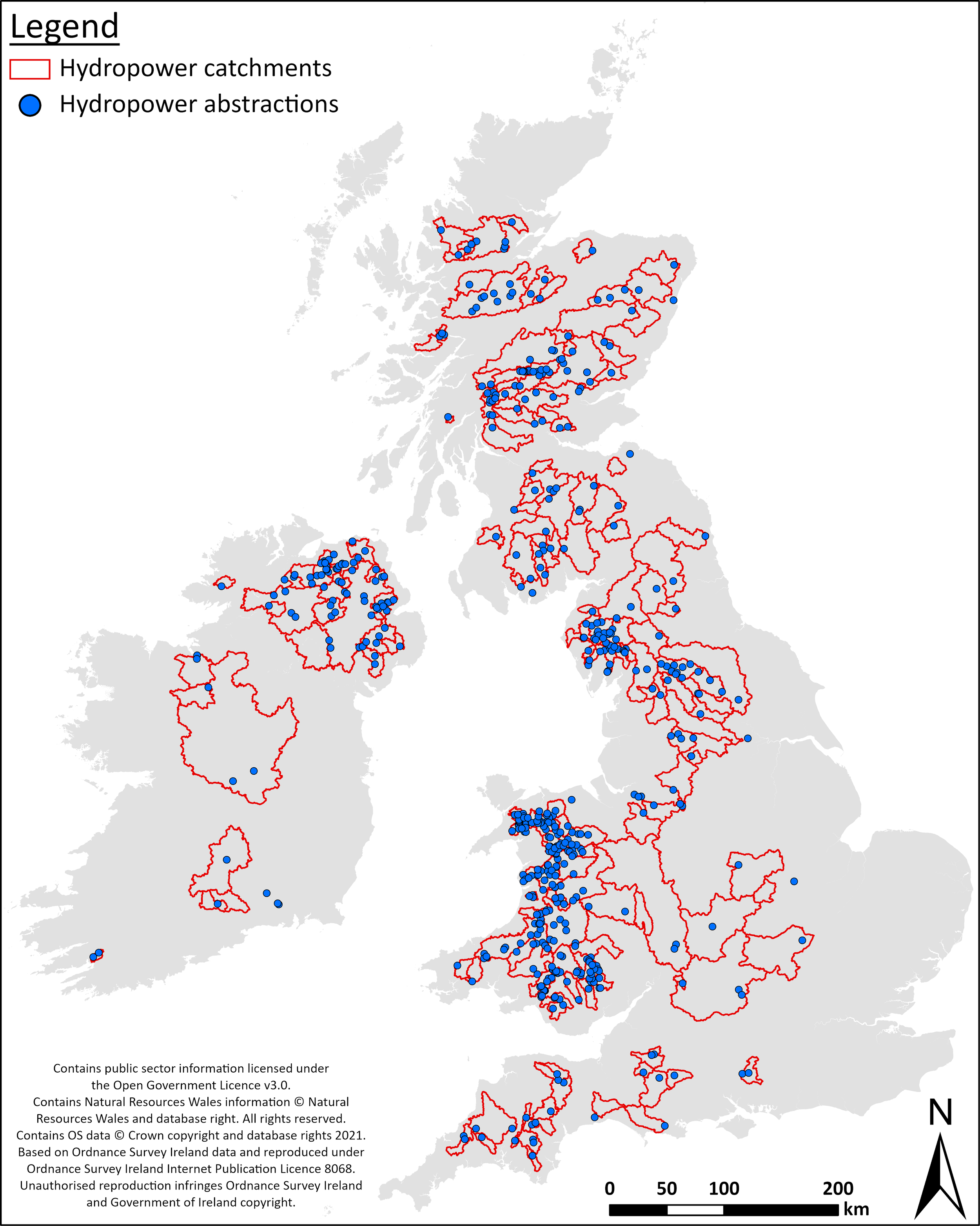Abstraction Licences and Hydropower
Comparison of abstraction licence conditions for the five nations of the UK and Ireland.
Studied catchments and hydropower abstractions in the UK and Ireland.
As has been shown by our previous research, future climate change is likely to have a substantial impact on the timing and quantity of future streamflows, with knock-on implications for water abstraction from streams, and therefore hydropower generation. This is particularly true of small run-of-river (RoR) type hydropower systems, which are highly dependent on instantaneous streamflows, as they have no reservoir or water impoundment to rely upon. Such RoR schemes are bound by their individually applied abstraction licences, which are set by the five environmental regulators that cover England, Wales, Scotland, Northern Ireland, and Ireland. These licences are in place to protect low and high flows in rivers, as well as flow variability, and are usually focussed on three key areas 1) hands-off-flow, 2) maximum abstraction, and 3) percentage take. In each of the five nations, the standard abstraction licence conditions (ALCs) that are likely to be applied to RoR schemes in non-ecologically or environmentally sensitive stream systems, vary in nature (as seen in the table). As these ALCs impact when and how much water can be abstracted, this logically has an impact on the timing and quantity of power generation from such schemes. It is therefore important to understand how these variations in ALCs between different nations impacts on water abstraction and power generation, with lessons likely to be able to be learned from the different approaches in different nations. Although hydropower plays a small role in renewable energy generation in the UK and Ireland, it is important to understanding how future generation capacity and characterises may be affected, for energy provision planning and reaching national emissions targets.
Our work models future streamflows at 531 RoR hydropower sites in 178 catchments across the British Isles and is based on a worst-case scenario of future climate change, using Representative Concentration Pathway 8.5 from the Intergovernmental Panel on Climate Change (IPCC). Modelling work has been conducted using the EXP-HYDRO hydrological model, with the latest climate change projections for the British Isles, the UK Climate Projections 2018 dataset (UKCP18). The daily amount of water available for abstraction at each scheme during the future modelled period has been calculated using the standard ALCs for each nation studied, with these then being compared. An estimation of the impact in terms of power generation has then also been made.
Annual total abstraction (1985-2015) for England, Wales, Scotland, Northern Ireland, and Ireland, under each nations’ standard abstraction licence conditions (ALCs). Blue boxes denote the status quo for each nation (i.e., total abstraction for the nation using their own ALCs). Quoted percentages show the difference from that nation’s total 1985-2015 abstraction under their own ALCs.
Our results suggest that the ALCs applied by the Welsh environmental regulator (Natural Resources Wales [NRW]), would have historically (1985-2015) provided the largest abstraction potential, and therefore electricity generation potential, when applied to all five nations studied. This is due to the fact that NRW’s regulations, although being lower in terms of maximum abstraction value than those in England and Scotland, Wales’s have a higher percentage take. This means that a greater proportion of flow after the hands-off-flow volume has been reached, can be abstracted and used. Conversely, the ALCs applied in England, by the Environment Agency (EA), perform least well in terms of water abstraction. When looking at power generation potential, summed to Great Britain and Island of Ireland individually, the same patterns can be found for the five nations’ ALCs.
Estimated and normalised annual total power generation (2020-2079) for Great Britain (GB) and the island of Ireland (IoI), under each nations’ standard abstraction licence conditions (ALCs). Blue boxes denote the status quo for each nation (i.e., total power generation when each nation is using their own ALCs). Quoted percentages show the difference from the total 2020-2079 power generation if each nation is using their own ALCs.
In terms of water abstraction from future modelled streamflows, the patters seen are near identical to those seen in the historical analysis, with the Welsh ALCs outperforming the other nations in terms of total water abstraction of the 60-year period studied (2020-2079). Under all ALCs, there is a general decline in water abstraction potential for hydropower however, due to declining streamflows in the future modelled scenario. This leads to a general decline in power generation potential under all ALCs, as shown in the figure below. However, despite the general decline in power generation across the 60 years studied, ALCs from Wales and Scotland still provide a net benefit in terms of total power generation across the period, when compared with the standard of each individual nation using their own ALCs.
Overall, this work has shown that making use of lower flows maximises RoR hydropower abstraction more than the capability to make use of more occasional higher flows. However, there is a fine balance between maximum abstraction volume and percentage take, for optimal water abstraction, which requires careful planning. In addition, while making changes to ALCs may aid in producing more hydropower in the future, it is difficult to retrofit currently installed schemes to make use of these. Therefore, the greatest value could be sought by designing new schemes with future flows in mind (rather than historical), to maximise power generation over the life of a scheme. Of course, such changes to abstraction licensing also requires regulatory changes and careful planning in order to optimise abstraction, while preserving protection for ecology, environment and other stakeholder interests.
This work is currently under review for publication, keep an eye on our website and Twitter page for updates, and to see the full results, when they are available.




